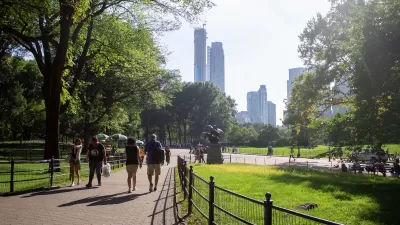Study finds people walk more in denser cities with more parks no matter what their country of origin.

Walkable cities really do get people walking. According to a cross sectional study of cities around the world found that, "The biggest design factors affecting the amount of 'moderate to vigorous intensity physical activity,' including walking, were: residential density, park and public transport density, and intersection density," writes Charlie Sorrel in an article for Fast Coexist.
The study, which was carried out in 14 cities sought to, "determine whether or not the cities' layouts themselves were the reason for increased health, as opposed to different lifestyles in different countries," Sorrel writes. The researches found that in cities as different as Baltimore and Bogota, "Dense, mixed-use city streets, with high walkability and ready access to good public transit: We've heard those criteria before. But this study is important because it shows that these factors lead to better public health independent of the economic status of the city or the cultural differences in different countries."
FULL STORY: The Well-Designed City Is A Healthy City, All Over The World

Alabama: Trump Terminates Settlements for Black Communities Harmed By Raw Sewage
Trump deemed the landmark civil rights agreement “illegal DEI and environmental justice policy.”

Study: Maui’s Plan to Convert Vacation Rentals to Long-Term Housing Could Cause Nearly $1 Billion Economic Loss
The plan would reduce visitor accommodation by 25% resulting in 1,900 jobs lost.

Why Should We Subsidize Public Transportation?
Many public transit agencies face financial stress due to rising costs, declining fare revenue, and declining subsidies. Transit advocates must provide a strong business case for increasing public transit funding.

Paris Bike Boom Leads to Steep Drop in Air Pollution
The French city’s air quality has improved dramatically in the past 20 years, coinciding with a growth in cycling.

Why Housing Costs More to Build in California Than in Texas
Hard costs like labor and materials combined with ‘soft’ costs such as permitting make building in the San Francisco Bay Area almost three times as costly as in Texas cities.

San Diego County Sees a Rise in Urban Coyotes
San Diego County experiences a rise in urban coyotes, as sightings become prevalent throughout its urban neighbourhoods and surrounding areas.
Urban Design for Planners 1: Software Tools
This six-course series explores essential urban design concepts using open source software and equips planners with the tools they need to participate fully in the urban design process.
Planning for Universal Design
Learn the tools for implementing Universal Design in planning regulations.
Smith Gee Studio
Alamo Area Metropolitan Planning Organization
City of Santa Clarita
Institute for Housing and Urban Development Studies (IHS)
City of Grandview
Harvard GSD Executive Education
Toledo-Lucas County Plan Commissions
Salt Lake City
NYU Wagner Graduate School of Public Service





























